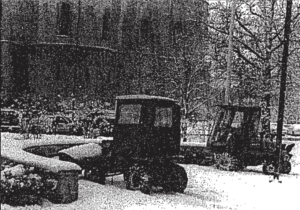Is it Worth the Read? Ariel

Image courtesy of amazon.com
By Caroline Morris
We were all forced to read poetry in high school. A 30-year-old English teacher in an oversized cardigan and colored jeans gave us Shakespeare’s sonnets and Whitman’s wonderings, casting pearls before ungrateful swine. There is no judgment here; I was one of them.
Now, having studied English for a few years at college, I have gained much more appreciation for poetry. I finally get what meter is, can tell you how the sonnet engages with literary tradition, and can explain how free-verse poetry diverges from said tradition. Despite my love and appreciation for formal poetry, I still find myself most moved by, most drawn to the confessional, post-modernist poets. Particularly, Sylvia Plath.
Though Sylvia Plath had one collection of poetry that was published before her death in 1963, Colossus and Other Poems (1960), her most famous collection is Ariel, published posthumously in 1965.
This collection of poetry is a worthy read for many reasons. Primarily, its themes of the feminine, motherhood, death, grief, and mental health all persist to the modern-day, and Plath has a gift for articulating these typically ineffable experiences. Additionally, she, alongside figures like Anne Sexton, was a pioneer female voice in the male-dominated field of literature, which automatically lends her work value in simply having existed and made space for itself. Lastly, Plath’s style, with its vivid images, intense (and often grotesque) diction, and accessible language and voice, make her poems ones which a beginner reader can understand instinctively, even if they could not articulate why Plath’s choices are ultimately so effective.
The first lines of the opening poem of the collection, “Morning Song,”read, “Love set you going like a fat gold watch. / The midwife slapped your footsoles, and your bald cry / Took its place among the elements.”
“Morning Song” dives immediately into those themes of motherhood and the feminine. There is a tension in the first stanza, as it opens with love, but is quickly contrasted against words with negative connotations, such as “fat,” “slapped,” and “bald cry.” Even just in the opening images, Plath is able to balance the goodness she feels in motherhood alongside its weightier aspects.
This continues throughout the poem, as she loses sleep because she waits “all night” to listen to her baby breathe and then must “stumble from bed, cow-heavy and floral.” In her diction, Plath is able to depict the reality of motherhood, with its joys and sacrifices, in a way that does not seem to impose bitterness or judgment on those struggles, nor false brightness about how motherhood only reaps joy.
One of the most famous poems from this collection is “Lady Lazarus,” which deals with the female role in society and Plath’s own mental health.
Plath had intense struggles with mental health and made multiple failed suicide attempts before killing herself in 1963. The poem opens in reference to those attempts: “I have done it again. / One year in every ten / I manage it–”. She continues later, “And I a smiling woman. / I am only thirty. / And like a cat I have nine times to die.”
The explicit engagement with her sucide attempts and mental health was quite taboo during Plath’s time, and this blunt discussion of it is part of what marks her work as “confessional.” We know from her personal history that this speaker is not a persona–it is Plath. The knowledge that this poem is relating a real-life experience makes it more powerful, and Plath embraces and uses intensity as a tool to discuss female gender roles.
She relates her experience to being rescued as a forced performance: “The peanut-crunching crowd / shoves in to see / Them unwrap me hand and foot– / the big strp tease.”
Plath’s returns to life are not willing, and when she does she also returns to the same role she had attempted to escape: a woman, sexualized, on display for the entertainment of the masses (in particular, for men, who force her into those roles). She addresses them in the poem: “So, so, Herr Doktor. So, Herr Enemy. / I am your opus, / I am your valuable, / The pure gold baby.” In naming these figures that pull her unwillingly back to life, she turns herself into a passive object to be controlled and hoarded, a baby to be infantilized, an idol to be worshiped. It is a scathing indictment of the role she is being forced back into simply by virtue of being alive.
The ending of this poem is the most powerful. It reads, “Beware/ Beware. / Out of the ash / I rise with my red hair / And I eat men like air.”
Plath depicts herself resurrecting, but not how the men want her to. Rather than return as a submissive woman, she comes back as a creature that is “other,” with flaming hair and a taste for vengeance and male flesh. It is a promise that if they force her to live, it will not be according to their suffocating and exploitative rules.
One final poem to examine is “Daddy,” another one of Plath’s famous pieces from this collection. This poem, like her previously published “Colossus,” is centered around her father, who died when she was a child. Plath writes some incredibly poignant lines that deal with such grief, in particular the section that reads, “I was ten when they buried you. / At twenty I tried to die / And get back, back, back to you. / I thought even the bones would do.” The poem deals with her grief in a powerful, gut wrenching manner.
However, there is a bit of indictment of her father throughout the poem, which is a theme that puzzles many readers and scholars. The ending stanza reads, “There’s a stake in your fat black heart / And the villagers never liked you. / … / Daddy, daddy, you bastard, I’m through.”
Plath’s father, Otto Plath, was of German descent and was potentially a German sympathizer during World War II. This is a reality about her father that Plath would have had to negotiate and was clearly on her mind as many of her poems include Holocaust references and metaphors, including “Daddy.” This choice to use the Holocaust as a poetic tool is one that readers and scholars still discuss today and is an element of this collection, along with some racial slurs, that a reader should know about for their own comfort level when entering into this collection.
Given this context, this section at least feels as though Plath is struggling with the universal human experience of how to deal with the flaws of a dead loved one who, as they are dead, you crave to idolize. The language she uses to do so is a different debate entirely, but the core idea is one that provokes deep reflection on the nature of grief.
I highly recommend Ariel as a collection. It is not perfect–I do not entirely understand the chunk of poems in the middle that focus on bees, and there are the upsetting elements having to do with marginalized groups as stated above. However, the majority of the poems in the collection are gems that get to the heart of many human issues in language that is punchy and affective. Sylvia Plath may just be the one to make you like poetry.







